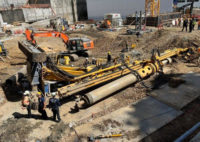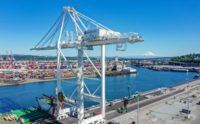City Grill

Michael Harder
VP and General Manager
Mortenson
The health of Seattle’s construction industry can be measured by the forest of cranes that are towering over the downtown skyline.
According to the Rider Levett Bucknall Crane Index, the 51 cranes in Seattle over the first quarter of 2022 was the most for any city in the U.S.
The multitude of cranes stands as a testament to the numerous large-scale projects underway in the city, according to Harder.
“We have a very strong economy in Washington state, supported by innovative companies, and we have recently experienced significant job growth,” Harder says. “Therefore, I am confident that we are in an excellent position compared to the rest of the country.”
This analysis is corroborated by Dodge Data & Analytics’ assessment of project starts. Although 2023 total starts for the city are expected to decline to $14.7 billion, the overall trend has been upward. Between 2020 and 2022, project starts increased by more than 7%, with a projected growth of 9% in 2024 compared with 2022, Dodge reports.
And, according to Washington State Employment Security Dept., the employment in construction is up 8,700 over the past 12 months, led by an increase of 4,500 jobs for specialty trade contractors.
Seattle’s performance in certain areas has been particularly robust. Dodge noted that the city ranked among the top 10 markets nationally with $6.8 billion in commercial and multifamily starts during the first half of 2022.
That performance could be seen in the 2022 Northwest Top Starts list. Two of the top construction starts in the city last year were the $400-million Civic Square Residential Condominiums and the $162-million Unison at Elliot Bay.
Another sector that has remained steady after reaching a peak in 2021 is education.
“I am confident that we are in an excellent position compared to the rest of the country.”
—Michael Harder, VP and General Manager, Mortenson
Earlier this year, Mortenson commenced construction on the $73.6-million Kaiser Borsari Hall at Western Washington University in Bellingham. This 54,000-sq-ft building will serve as the university’s new facility for electrical and computer engineering, energy science and computer science. Once completed, it will be the first carbon net neutral collegiate facility in the state of Washington.
However, the region is not immune to the broader economic concerns affecting the construction industry. While pandemic-related challenges such as disrupted supply chains have improved, shortages of staff and materials persist. Costs have cooled off slightly but remain high.
Moreover, if inflation continues and interest rates rise as a consequence, financing for private projects could face difficulties.
“In light of an uncertain economy, we have witnessed our customers pausing their projects. Nevertheless, I am hopeful that with stabilized construction inflation and interest rates, our customers will be able to proceed with their projects in due course,” says Harder.
Despite these challenges, construction firms are likely to have public projects to pursue thanks to the emphasis placed on infrastructure investment in recent years, particularly in the transportation sector.
“Seattle has a unique advantage with a significant amount of ongoing and upcoming work associated with major institutions such as the Port of Seattle and Sound Transit,” says Harder. Dodge’s data confirms this, showing a 48% increase in highway and bridge starts between 2020 and 2023.
This trend is expected to continue, thanks to the ambitious transportation funding bill passed during the last legislative session. The package allocates $17 billion over the next 16 years for a wide range of projects.
In addition to $4 billion for priority road and bridge projects, the package includes $4.3 billion for transit, bicycle and pedestrian projects as well as $1.5 billion for the state ferry system.
Furthermore, federal funds will play a major role.
“The most significant opportunity I see is the stimulus generated by the Inflation Reduction Act and its impact on carbon reduction, energy projects and innovation practices,” notes Harder. “We are already witnessing the emergence of several large projects in Central and Eastern Washington as a result of these trends.”






Post a comment to this article
Report Abusive Comment